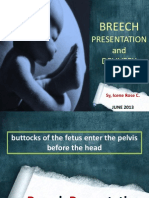Fontanilla, Crista Mae F.: Objective
Fontanilla, Crista Mae F.: Objective
Uploaded by
tam meiCopyright:
Available Formats
Fontanilla, Crista Mae F.: Objective
Fontanilla, Crista Mae F.: Objective
Uploaded by
tam meiOriginal Description:
Original Title
Copyright
Available Formats
Share this document
Did you find this document useful?
Is this content inappropriate?
Copyright:
Available Formats
Fontanilla, Crista Mae F.: Objective
Fontanilla, Crista Mae F.: Objective
Uploaded by
tam meiCopyright:
Available Formats
Fontanilla, Crista Mae F.
1.) Unexpected association between diseases and symptom Simultaneous presentation of Kaposi sarcoma and HHV8-associated large B-cell lymphoma in the same lymph node: A rare diagnosis in an HIV-negative patient. Abstract Patient: Female, 18 Final Diagnosis: Simultanous presentation of Kaposi Sarcoma and Lymphoma Symptoms: - Medication: - Clinical Procedure: - Specialty: Oncology. OBJECTIVE: Rare disease. BACKGROUND: KSHV/HHV-8 is associated with Kaposi's sarcoma (KS) as well as with a few categories of lymphoproliferative diseases, mostly occurring in patients with HIV infection/AIDS. Although the association between lymphomas and Kaposi's sarcoma has been described, the simultaneous presence of the 2 entities within the same organ is rare and mainly associated with HIV/ AIDS. CASE REPORT: We report a case of simultaneous occurrence of Kaposi's sarcoma and large B-cell lymphoma in the same lymph node in a 18-year-old African woman who was HIV-negative. We found concurrent infection with Kaposi's sarcoma herpes virus (KSHV) and Epstein-Barr virus (EBV), confirmed by PCR amplification of DNA obtained from distinct tumor areas selected in the paraffin block. CONCLUSIONS: The possibility of occurrence of 2 lesions with distinct features in the same organ may be unexpected for pathologists performing fine-needle aspiration cytology (FNAC) evaluation but must be considered, even in HIV-negative individuals, despite its rare occurrence, as was demonstrated by this case.
2.) Unexpected event in the course of observing and treating a patient Sudden blast crisis in a chronic myeloid leukemia patient during imatinib therapy. Abstract Imatinib mesilate (IM) is the first line therapy for chronic myeloid leukemia (CML) patients in chronic phase. Although it offers a complete cytogenetic response (CCyR) in a majority of patients, there still are some rare cases in which a sudden blast crisis (SBC) evolves. The mechanism of this unexpected event is not yet completely understood. We present the case of a female patient who developed a SBC while being under IM therapy. We do not know for sure which is the role of IM in this event, but current available data suggest that this drug may have a permissive effect on the evolution of some aggressive subclones in the context of restored normal cell population.
3.) Findings that shed new light on the possible pathogenesis of a disease or an adverse effect LRG1 promotes angiogenesis by modulating endothelial TGF- signalling. Abstract Aberrant neovascularization contributes to diseases such as cancer, blindness and atherosclerosis, and is the consequence of inappropriate angiogenic signalling. Although many regulators of pathogenic angiogenesis have been identified, our understanding of this process is incomplete. Here we explore the transcriptome of retinal microvessels isolated from mouse models of retinal disease that exhibit vascular
pathology, and uncover an upregulated gene, leucine-rich alpha-2-glycoprotein 1 (Lrg1), of previously unknown function. We show that in the presence of transforming growth factor-1 (TGF-1), LRG1 is mitogenic to endothelial cells and promotes angiogenesis. Mice lacking Lrg1 develop a mild retinal vascular phenotype but exhibit a significant reduction in pathological ocular angiogenesis. LRG1 binds directly to the TGF accessory receptor endoglin, which, in the presence of TGF-1, results in promotion of the pro-angiogenic Smad1/5/8 signalling pathway. LRG1 antibody blockade inhibits this switch and attenuates angiogenesis. These studies reveal a new regulator of angiogenesis that mediates its effect by modulating TGF- signalling.
4.) Unique or rare features of a disease Fever of unknown origin as the first manifestation of colonic pathology. Abstract
Fever of unknown origin (FUO) is an entity caused by more than 200 diseases. Haematologic neoplasms are the most common malignant cause of FUO. Fever as a first symptom of colonic tumour pathology, both benign and malignant, is a rare form of presentation. Our work is a descriptive study of a series of 23 patients with colonic tumoral pathology who presented with fever of unknown origin. The mean age was 67.6 years; 56.5% of patients were men and 43.5% were women. Primary malignant neoplasia was the most common diagnosis. Blood cultures were positive in 45% of the samples. Coagulase-negative staphylococci were the most common cause of bacteraemia. Nine of 10 faecal occult blood tests performed were positive. Fever secondary to colon neoplasms, both benign and malignant, usually presents with a bacteraemic pattern, with positive results for blood-culture tests in a high percentage of cases.
5.) Unique therapeutic approaches Therapeutic effect of hyperbaric oxygen on inclusion body myositis. Abstract An inflammatory myopathy, inclusion body myositis (IBM) presents with progressive muscle weakness against a background of elevated creatine kinase and diffuse endomysial damage. Typically occurring in patients greater than 50 years of age, it is commonly misdiagnosed as polymyositis or other rheumatological disease and is often ineffectively treated with steroids [1]. The approach to IBM is frequently a clinical challenge due to its unique and often aberrant response to common treatment modalities. Here we report an apparent improvement in the clinical course of and associated laboratory findings in a patient with co-existing IBM following the use of hyperbaric oxygen therapy as an adjunct for managing ischemic colitis.
6.) Positional or quantitative variation of the anatomical structure Failure of supraclavicular block under ultrasound guidance: clinical relevance of anatomicalvariation of cervical vessels. Abstract We describe a case with partial analgesia after ultrasound-guided supraclavicular block for elbow surgery. The failure of the block was caused by the limited spread of local anesthetic because of blockage by a vessel (either transverse cervical artery or dorsal scapular artery) running through the brachial plexus. Anesthesiologists should be aware that cervical anatomy is complex and has anatomical variations. Thus, careful ultrasound screening of anatomical structure, especially using color Doppler, is important in performing brachial plexus block.
You might also like
- Psychology - Masters in Psychology Entrance Examination Book (Power Within Psychology, Amit Panwar) (Z-Library)Document414 pagesPsychology - Masters in Psychology Entrance Examination Book (Power Within Psychology, Amit Panwar) (Z-Library)Suraj100% (16)
- Biochemistry Viva QuestionsDocument266 pagesBiochemistry Viva Questionswillson95% (88)
- D2011 TD2011 PDFDocument388 pagesD2011 TD2011 PDFampacparts100% (2)
- Ma. Elizabeth F. FontanillaDocument48 pagesMa. Elizabeth F. Fontanillatam mei100% (1)
- VacancyDocument5 pagesVacancyabcdNo ratings yet
- 78 Days Practical TransurfingDocument7 pages78 Days Practical TransurfingKarim Adel67% (6)
- Anesthesia For Systemic Lupus Erythematosus ReviewDocument12 pagesAnesthesia For Systemic Lupus Erythematosus ReviewAnonymous x75qV3lGNo ratings yet
- LAL Case Report2Document3 pagesLAL Case Report2hematocosas123No ratings yet
- Lupus NephritisDocument3 pagesLupus NephritissobanNo ratings yet
- Acute Lymphoblastic LeukemiaDocument34 pagesAcute Lymphoblastic LeukemiamtyboyNo ratings yet
- غير معروف Chronic Leukemia-8 (Muhadharaty)Document60 pagesغير معروف Chronic Leukemia-8 (Muhadharaty)aliabumrfghNo ratings yet
- 10 11648 J CRJ 20200802 14Document3 pages10 11648 J CRJ 20200802 14Marj MendezNo ratings yet
- 1757 1626 1 333Document5 pages1757 1626 1 333Ade CandraNo ratings yet
- Poster LESDocument6 pagesPoster LESAlejandra LuqueNo ratings yet
- Chronic Lymphocytic LeukemiaFrom EverandChronic Lymphocytic LeukemiaMichael HallekNo ratings yet
- Chronic Myeloid LeukaemiaDocument30 pagesChronic Myeloid Leukaemiajismi vallachiraNo ratings yet
- Acute Lymphoblastic Leukemia: Differential DiagnosisDocument6 pagesAcute Lymphoblastic Leukemia: Differential DiagnosisIma OhwNo ratings yet
- Biology Investigatory Project CMLDocument16 pagesBiology Investigatory Project CMLABHISHEK AjithkumarNo ratings yet
- DR Janice L Hinkle, Kerry H Cheever Brunner & Suddarth's Textbook-2668-2681Document14 pagesDR Janice L Hinkle, Kerry H Cheever Brunner & Suddarth's Textbook-2668-2681Sofil fNo ratings yet
- Background: Pediatric Acute Lymphoblastic LeukemiaDocument3 pagesBackground: Pediatric Acute Lymphoblastic LeukemiaNitin KumarNo ratings yet
- Edit Case AnalysisDocument25 pagesEdit Case AnalysisAmel YangNo ratings yet
- Practice EssentialsDocument34 pagesPractice Essentialsfadli aditya rizkyNo ratings yet
- Antiphospholipid SyndromeDocument8 pagesAntiphospholipid SyndromeVijeyachandhar DorairajNo ratings yet
- Wall 2016Document15 pagesWall 2016Jose AbadiaNo ratings yet
- LeukaemiaDocument9 pagesLeukaemiaXsmsma XsosoNo ratings yet
- Kikushi Final HandoutDocument10 pagesKikushi Final HandoutAnas ObiedNo ratings yet
- Practice: Kikuchi-Fujimoto Disease: Lymphadenopathy in SiblingsDocument4 pagesPractice: Kikuchi-Fujimoto Disease: Lymphadenopathy in SiblingsBobby Faisyal RakhmanNo ratings yet
- Introductions in AbstractsDocument6 pagesIntroductions in Abstractsrobhel74No ratings yet
- Aplastic Anemia: Review of Etiology and TreatmentDocument7 pagesAplastic Anemia: Review of Etiology and TreatmentCleber MaiaNo ratings yet
- Glo Me Rulo NephritisDocument19 pagesGlo Me Rulo NephritisAshley HumphreyNo ratings yet
- Hematology Mccq1Document236 pagesHematology Mccq1javaheri.abdorrazaghNo ratings yet
- Kikuchi-Fujimoto Disease: Adhikari RCDocument5 pagesKikuchi-Fujimoto Disease: Adhikari RCRam Chandra AdhikariNo ratings yet
- An Sell 2005Document11 pagesAn Sell 2005Rachel AutranNo ratings yet
- MR 25Document9 pagesMR 25Riko JumattullahNo ratings yet
- Ojim 2016091213324550Document10 pagesOjim 2016091213324550rianmg21No ratings yet
- Case StudyDocument10 pagesCase Studysabrown109No ratings yet
- Lymphoma Shofik EDITED BY SAYAM 8.53PMDocument35 pagesLymphoma Shofik EDITED BY SAYAM 8.53PMRAGHU NATH KARMAKERNo ratings yet
- Pediatric Acute Lymphoblastic LeukemiaDocument9 pagesPediatric Acute Lymphoblastic LeukemiaAlvin PratamaNo ratings yet
- Malignant Mesothelioma Presenting With Unexplained Recurrent Pleurisy EpisodesDocument4 pagesMalignant Mesothelioma Presenting With Unexplained Recurrent Pleurisy EpisodesNurul NingrumNo ratings yet
- Hodgkin's Lymphoma - LancetDocument9 pagesHodgkin's Lymphoma - LancetSurenderSingh100% (1)
- A Chronic Lymphocytic Leukemia Patient With Progressive Multifocal Leukoencephalopathy Caused by John Cunningham VirusDocument8 pagesA Chronic Lymphocytic Leukemia Patient With Progressive Multifocal Leukoencephalopathy Caused by John Cunningham VirusYtyNo ratings yet
- BR J Haematol - 2016 - Kritharis - How I ManageDocument6 pagesBR J Haematol - 2016 - Kritharis - How I ManageMarco Aurélio SartoriNo ratings yet
- Pages 4 7Document4 pagesPages 4 7andreas_251650No ratings yet
- USMLE Step 3 Answers To ARCHER Q Bank 1-25Document15 pagesUSMLE Step 3 Answers To ARCHER Q Bank 1-25rashmiajNo ratings yet
- SFSDDocument21 pagesSFSDblain mathewNo ratings yet
- Caso AuntmineDocument19 pagesCaso AuntmineJuan Manuel Chino MendozaNo ratings yet
- Assignment 1 Pathology Aplastic Anemia: Supervisor: DR - Ramez Al-KeelaniDocument6 pagesAssignment 1 Pathology Aplastic Anemia: Supervisor: DR - Ramez Al-Keelaniameer mousaNo ratings yet
- Leukemoid Reaction As A "Prognostic Marker" in Breast Cancer and Review of LiteratureDocument4 pagesLeukemoid Reaction As A "Prognostic Marker" in Breast Cancer and Review of LiteratureEditor_IAIMNo ratings yet
- TMP 103 EDocument4 pagesTMP 103 EFrontiersNo ratings yet
- Acute Lymphoblastic Leukemia RadiopediaDocument2 pagesAcute Lymphoblastic Leukemia RadiopediaRani Henty NovitaNo ratings yet
- Hodgkins Disease Case StudyDocument7 pagesHodgkins Disease Case StudyLyonsGraham100% (1)
- Clinical Manifestations, Pathologic Features, and Diagnosis of Acute Promyelocytic Leukemia in AdultsDocument10 pagesClinical Manifestations, Pathologic Features, and Diagnosis of Acute Promyelocytic Leukemia in AdultsANDREEA-CORNELIA NECULCEANo ratings yet
- Lecture 14Document35 pagesLecture 14Zainab Noor ShahidNo ratings yet
- PHOJ D 24 00049 - ReviewerDocument11 pagesPHOJ D 24 00049 - ReviewerAdityaNo ratings yet
- Cerebral Vein Thrombosis Associated With MTHFR A1289C Mutation Gene in A Young Postpartum WomanDocument5 pagesCerebral Vein Thrombosis Associated With MTHFR A1289C Mutation Gene in A Young Postpartum WomanMauro Porcel de PeraltaNo ratings yet
- Antiphospholipid Antibody SyndromeDocument37 pagesAntiphospholipid Antibody SyndromeAhmad Reshad AslamNo ratings yet
- Defining The Stages of Aggressive Non-Hodgkin's LymphomaDocument3 pagesDefining The Stages of Aggressive Non-Hodgkin's LymphomaomarbenhagiNo ratings yet
- PDFDocument29 pagesPDFandreas_251650No ratings yet
- Jadaon - 2011 - Epidemiology of Activated Protein C Resistance and Factor V Leiden Mutation in The Mediterranean RegionDocument11 pagesJadaon - 2011 - Epidemiology of Activated Protein C Resistance and Factor V Leiden Mutation in The Mediterranean RegionnadaNo ratings yet
- Lupus NephritisDocument39 pagesLupus NephritisGowrisangarNo ratings yet
- Acute Myeloid Leukemia ThesisDocument5 pagesAcute Myeloid Leukemia ThesisBuyCheapEssayOmaha100% (2)
- Chronic LeukemiaDocument12 pagesChronic LeukemiaJuan RamirezNo ratings yet
- American J Hematol - 2023 - Cheah-2Document14 pagesAmerican J Hematol - 2023 - Cheah-2salman mehriNo ratings yet
- Treatment of Acquired HemophiliaDocument7 pagesTreatment of Acquired HemophiliaLuana MNo ratings yet
- How I Treat Hyperleukocytosis in Acute Myeloid LeukemiaDocument7 pagesHow I Treat Hyperleukocytosis in Acute Myeloid LeukemiaMarcela PauletteNo ratings yet
- Psa Recommendations FOR Standard Practice For AnesthesiologistsDocument10 pagesPsa Recommendations FOR Standard Practice For Anesthesiologiststam meiNo ratings yet
- Transverse Myelitis Preexisting in Pregnancy A Case ReportDocument6 pagesTransverse Myelitis Preexisting in Pregnancy A Case Reporttam meiNo ratings yet
- SPG 16 10460Document13 pagesSPG 16 10460tam meiNo ratings yet
- Psa Isura 2019Document11 pagesPsa Isura 2019tam meiNo ratings yet
- Aendicus 3 UpdateDocument13 pagesAendicus 3 Updatetam meiNo ratings yet
- MBFH Self Assessment TestDocument20 pagesMBFH Self Assessment Testtam meiNo ratings yet
- Drug Index Updated2Document113 pagesDrug Index Updated2tam meiNo ratings yet
- Biochem Post TestDocument9 pagesBiochem Post Testtam meiNo ratings yet
- Pelvic Inflamatory DiseaseDocument8 pagesPelvic Inflamatory Diseasetam mei100% (1)
- Breech DeliveryDocument35 pagesBreech Deliverytam mei100% (2)
- Cadiovascular DiseasesDocument12 pagesCadiovascular Diseasestam meiNo ratings yet
- Cityassessor Sworn Statement PDFDocument1 pageCityassessor Sworn Statement PDFtam mei0% (1)
- Nephrotic and NephriticDocument27 pagesNephrotic and Nephritictam meiNo ratings yet
- Cardiac RadiologyDocument17 pagesCardiac Radiologytam meiNo ratings yet
- Filipino Bread PuddingDocument1 pageFilipino Bread Puddingtam meiNo ratings yet
- Sworn Declaration of No Improvement On Real Property: (Date of Sale/donation/death of Decedent)Document1 pageSworn Declaration of No Improvement On Real Property: (Date of Sale/donation/death of Decedent)tam meiNo ratings yet
- Aherrera NotesDocument213 pagesAherrera NotesVerna Santiago71% (7)
- Jurnal HegDocument7 pagesJurnal HegAmanda Mahendra SastranegaraNo ratings yet
- Guinataang Mais (Corn in Coconut Milk) : (Conversions For Cooking)Document1 pageGuinataang Mais (Corn in Coconut Milk) : (Conversions For Cooking)tam meiNo ratings yet
- (Kitchen Conversion) : IngredientsDocument1 page(Kitchen Conversion) : Ingredientstam meiNo ratings yet
- (Cooking Measurements) : IngredientsDocument1 page(Cooking Measurements) : Ingredientstam meiNo ratings yet
- Champorado: (Measurements Cooking)Document1 pageChamporado: (Measurements Cooking)tam meiNo ratings yet
- Head First C Sharp 3rd Edition Jennifer Greene Andrew StellmanDocument51 pagesHead First C Sharp 3rd Edition Jennifer Greene Andrew StellmanArchna Chugh100% (1)
- Week 3 HRMDocument6 pagesWeek 3 HRMIsha LarionNo ratings yet
- CHALCOLITHIC CULTURES - kAYATHA - aHAR - Malwa - Jorwe Culture PDFDocument4 pagesCHALCOLITHIC CULTURES - kAYATHA - aHAR - Malwa - Jorwe Culture PDFvipul0457No ratings yet
- Sfu Certification GuideDocument43 pagesSfu Certification GuideSurajMallaNo ratings yet
- The Effects of Social Life On Academic Performance and Their Capability of Being A Leader of gr.11 STEM Students in HAUDocument2 pagesThe Effects of Social Life On Academic Performance and Their Capability of Being A Leader of gr.11 STEM Students in HAUCollette AustriaNo ratings yet
- Dassault Falcon Easy Flight DeckDocument8 pagesDassault Falcon Easy Flight Deckflyer fighterNo ratings yet
- Punto 1 EVALUACIONDocument6 pagesPunto 1 EVALUACIONYenny Paola Castrillon BelloNo ratings yet
- Notes For AA BookDocument15 pagesNotes For AA BookBrittany Nicole GrateNo ratings yet
- Resum CV App LetterDocument3 pagesResum CV App LetteryudimitsuNo ratings yet
- 1 GlassDocument45 pages1 GlassIkhwan BudimanNo ratings yet
- Class 12 English Practice Paper 01Document18 pagesClass 12 English Practice Paper 01Sonu ahmed0% (1)
- Module-20 - Earth and Life Quarter 1 Module 20 Module-20 - Earth and Life Quarter 1 Module 20Document27 pagesModule-20 - Earth and Life Quarter 1 Module 20 Module-20 - Earth and Life Quarter 1 Module 20Najmah Sirad AmpaNo ratings yet
- Southwest Airlines: Rajeev R. Pandey Sudeep Byanju Sunil K Pokharel Umi Joshi Yubaraj ChaudharyDocument12 pagesSouthwest Airlines: Rajeev R. Pandey Sudeep Byanju Sunil K Pokharel Umi Joshi Yubaraj ChaudharyRashmi SinghNo ratings yet
- Thi thử KYS lần 9 - Môn Tiếng AnhDocument8 pagesThi thử KYS lần 9 - Môn Tiếng AnhNhư TâmNo ratings yet
- SKLep SSM DataSheet March 21 2023Document1 pageSKLep SSM DataSheet March 21 2023Piotr MatybaNo ratings yet
- Gemü 534 Robb - ÁbraDocument8 pagesGemü 534 Robb - ÁbraLászló FancsaliNo ratings yet
- Zuari Company ProfileDocument14 pagesZuari Company Profilesriswathi70100% (1)
- Term Loan/Project Appraisal A Presentation: by A K Mishra IifbDocument69 pagesTerm Loan/Project Appraisal A Presentation: by A K Mishra Iifbmithilesh tabhaneNo ratings yet
- 07 On Memory, Trauma, Public Space, Monuments, and MemorialsDocument9 pages07 On Memory, Trauma, Public Space, Monuments, and MemorialsKurdistan SalamNo ratings yet
- Pham Binh Minh Vietnam Shipbuilding IndustryDocument16 pagesPham Binh Minh Vietnam Shipbuilding IndustryDivaNo ratings yet
- Statistic Answer KeyDocument5 pagesStatistic Answer KeyOlive PelayoNo ratings yet
- Stabilizer Bars: Part 1. Calculations and Construction: Adam-Markus WITTEK, Hans-Christian RICHTERDocument18 pagesStabilizer Bars: Part 1. Calculations and Construction: Adam-Markus WITTEK, Hans-Christian RICHTERNemanja Kovac100% (1)
- Isabella WhitneyDocument7 pagesIsabella Whitneyapi-252345047No ratings yet
- Flexible Conduit Systems enDocument15 pagesFlexible Conduit Systems enSam ANo ratings yet
- PS2 Dumper v2.0Document3 pagesPS2 Dumper v2.0kyougiNo ratings yet
- f2f DLP Raiseplus Weekly PlanDocument2 pagesf2f DLP Raiseplus Weekly PlanJoyce CarilloNo ratings yet

















































































































